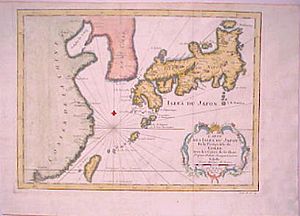Enkyō (Edo period) facts for kids
Enkyō (error: {{nihongo}}: Japanese or romaji text required (help)) was a special name for a period of time in Japanese history. These periods are called nengō. The Enkyō era came after the Kanpō era and before the Kan'en era.
This time period lasted from February 1744 to July 1748. During the Enkyō era, two emperors ruled Japan: Sakuramachi and Momozono.
What Happened During the Enkyō Era?
- 1744 (Enkyō 1): In 1744, which was the first year of Enkyō, a very bright comet could be seen in the sky for many months. This comet is now known as C/1743 X1 (De Cheseaux).
- 1745 (Enkyō 2): Tokugawa Ieshige became the new shogun of the Tokugawa shogunate. A shogun was a powerful military leader who ruled Japan for the emperor.
- 1745 (Enkyō 2): The first market fair was held in the capital region of Japan. This was a big event for buying and selling goods.
- 1745 (Enkyō 2, 2nd month): A very large fire swept through Edo, which is now known as Tokyo.
- 9 June 1747 (Enkyō 4, 21st day of the 4th month): Emperor Sakuramachi decided to step down from his role. This is called abdicating. His son then took over as the new emperor. Soon after, Emperor Momozono's role as the monarch (ruler) was officially confirmed with special ceremonies.
Related pages
- Edo period
- Enkyō (Kamakura period), 1308-1311
- National Diet Library, "The Japanese Calendar" -- historical overview plus illustrative images from library's collection

All content from Kiddle encyclopedia articles (including the article images and facts) can be freely used under Attribution-ShareAlike license, unless stated otherwise. Cite this article:
Enkyō (Edo period) Facts for Kids. Kiddle Encyclopedia.

